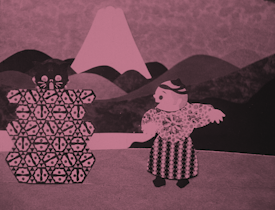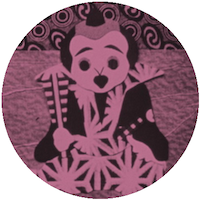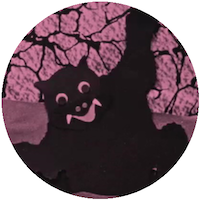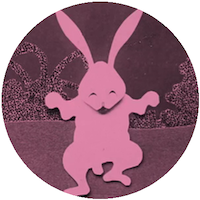At the Border Checkpoint
| Original Title | お関所 |
|---|---|
| Japanese kana Rendering | Osekisho |
| English Title | At the Border Checkpoint |
| Production Date | 1930 |
| Author | Noburo Ofuji |
| Duration (minutes) | 8 |
| Sound | silent |
| Color | b/w, tinted |
| Plot | When sparrows twitter and crows caw, the morning comes. This is a major border checkpoint in the Hakone mountains which attracts many groups of traveling entertainers from Mishima and Odawara. When the declaration is heard that "No one can go through this great border checkpoint without a pass," everyone without a steady job cringes as they do not have passes. Then, a nice official appears saying that anyone who can demonstrate their entertainment may pass through the border checkpoint. First, a monkey starts dancing, then a dog joins in, but that becomes a boxing match, which then gradually turns into dancing again. Finally, they dance the tango together. The above was created by supplementing missing parts with references to the outline of the story described in Kinema Junpo (キネマ旬報) and Eiga Kyoiku (映画教育). Next, a magician from China makes eight toy soldiers sing and dance to the song, "March of the Toys." At the end, the magician takes out a musical instrument like a guitar and sings "Tokyo March." As the music progresses, officials at the border checkpoint start dancing in joyful high spirits. The music goes over the mountain, reaches the ear of a rabbit, enters the burrow of a raccoon dog, and then even a bear starts dancing. In the middle of the dancing, an arms trader suddenly jumps in and starts a quarrel. A free-for-all breaks out, and the rabbit and raccoon dogs are killed, the bear and a horse are killed and their heads end up on each other’s bodies. Frightened by this big uproar, the officials say, "Just go through the checkpoint!" Everyone leaves in both directions singing a piece of the god of wealth song as cherry blossoms fall. |
| Description | The original is an Eastphone sound on disc system consisting of two reels with a total length of 463 meters and lasting 18min. Eastphone is a talkie system developed by Masao Tojo; the record disk synchronized with the projector was larger than an LP record and measured as much as 16 inches (approx. 41cm) in diameter. The existing version contains only the second reel and the sound is missing. According to the news column in Kinema Junpo (キネマ旬報) No. 363 published on April 21, 1930 (p. 13), sounds were being recorded at the Eastphone Talkie Studio in Tokyo's Omori with a performance by the 40 members of the Shochiku Gakugeki Division Orchestra conducted by Shiro Matsumoto. |
| Production Company | Chiyogami Eigasha* |
| Distribution | Chuo Eigasha* |
| Release Date | Jun 5, 1930 |
| Credits: Director | Noburo Ofuji* |
| Credits: Staff, Cast, etc. | |
| Intertitles | T1「終」。 |
| Censorship - Date and Number | [参考]内務省検閲番号:E6486(1930年5月20日) |
| References | ・「各社近作日本映画紹介 お關所」『キネマ旬報』1930年6月1日・第367号、74頁(写真あり)。 ・「千代紙細工トーキー映画 お關所」『映畫教育』1930年7月号・第29輯、6-7頁(写真あり)。 |
| Frames per Second | 24fps |
| Source of Digital Copy | The 35mm nitrate positive donated from individuals(tinted) -> The 35mm color internegative owned by NFC |
| Completeness | no main title no credit titles the former part is missing lack of sound |
| Additional Notes | simple digital restoration The mark of "*" will provide an additional explanation gained from the bibliographical information. |
| Related Links |
Related categrory
- Jidaigeki - period drama
- Musical
- Sword Fight
- Dance & Sing
- Cutout (Chiyogami)
- Person
- Bear
- Raccoon dog
- Rabbit
Main characters
Please tell us what you think about this website by filling out a short questionnaire.
To educational users: Please provide us with feedback on website usage for educational purposes.
- Unauthorized copying and replication of the contents on this site are prohibited.





